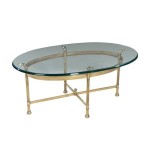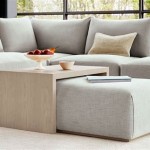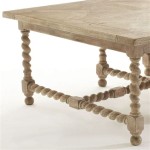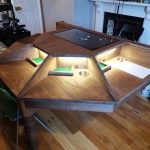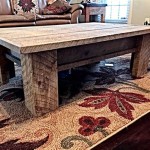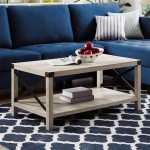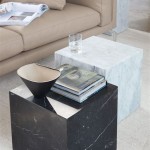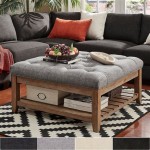How Big Should A Coffee Table Be Compared To Sofa Bed Size?
Selecting a coffee table for a living room that includes a sofa bed requires careful consideration to ensure both functionality and aesthetic harmony. The coffee table serves as a central element, offering a surface for beverages, books, and decorative items. However, its dimensions must be appropriately scaled to the size and configuration of the sofa bed, both when used as a sofa and when extended into a bed. An improperly sized coffee table can impede movement, disrupt the flow of the room, and detract from the overall comfort and visual appeal. This article will explore the key factors involved in determining the optimal size of a coffee table in relation to a sofa bed.
Height Considerations: Matching Coffee Table Height to Sofa Bed Seat Height
One of the most crucial aspects to consider is the height of the coffee table relative to the sofa bed's seat height. Ideally, the coffee table should be approximately the same height as the sofa bed's seat, or slightly lower. A coffee table that is significantly higher than the seat can feel awkward and impede comfortable use, making it difficult to reach items or rest drinks without straining. Conversely, a coffee table that is too low can be equally inconvenient, requiring excessive bending and creating a less accessible surface. A difference of no more than one or two inches in either direction is generally acceptable, but exceeding this can negatively impact the overall ergonomics and user experience.
To determine the optimal height, measure the seat height of the sofa bed from the floor to the top of the cushion. This measurement serves as the target height range for the coffee table. When browsing coffee table options, pay close attention to the product specifications and ensure that the height falls within the acceptable range. Some coffee tables feature adjustable legs or risers, offering flexibility in adjusting the height to achieve the perfect fit. If the sofa bed has particularly plush cushions that compress significantly when seated, it may be prudent to account for this compression when measuring the seat height, subtracting an inch or two to maintain optimal accessibility.
Length and Width: Proportionality to Sofa Bed and Room Dimensions
Beyond height, the length and width of the coffee table are equally important considerations. The coffee table should be proportional to the length of the sofa bed, occupying approximately one-half to two-thirds of the sofa's length. This ratio ensures that the coffee table visually balances the sofa and provides adequate surface area without overwhelming the space. A coffee table that is too short can appear insignificant, while one that is too long can create a cramped and cluttered feel. When the sofa bed is extended into a bed, the coffee table should not obstruct access to the bed or create a tripping hazard. Careful planning is therefore necessary to ensure both functionality and safety.
Consider the overall dimensions of the room when determining the ideal length and width of the coffee table. In smaller spaces, a smaller, more compact coffee table is generally preferable to avoid overwhelming the area. In larger rooms, a larger coffee table can be used to fill the space and create a more substantial focal point. Measure the available space between the sofa bed and any surrounding furniture or walls to ensure that the coffee table will fit comfortably without impeding movement. Leave at least 12 to 18 inches between the coffee table and the sofa bed to allow for comfortable legroom and easy access. Also, consider allowing at least 24 to 30 inches between the coffee table and any surrounding walls or furniture to avoid creating a constricted pathway.
The shape of the coffee table can also influence its perceived size and visual impact. Rectangular coffee tables are a classic choice, offering ample surface area and a clean, linear aesthetic. Round or oval coffee tables can soften the lines of a room and create a more inviting atmosphere. Square coffee tables can be a good option for smaller spaces, providing a compact and versatile surface. Consider the overall style and décor of the room when selecting the shape of the coffee table to ensure that it complements the existing furniture and creates a cohesive look. Irregular shaped coffee tables can add visual interest and serve as a statement piece, but they might be less practical in terms of surface area and require more careful consideration of placement and proportions.
Functionality and Usage: Considering the Sofa Bed's Dual Role
The dual functionality of a sofa bed as both a seating area and a sleeping space introduces unique considerations when selecting a coffee table. The coffee table should be easily movable or have a design that allows it to be readily repositioned when the sofa bed is converted into a bed. A lightweight coffee table or one with wheels or casters can be easily moved out of the way when needed. Alternatively, a coffee table with a lift-top mechanism can provide a convenient surface for eating or working while seated on the sofa bed, and can be lowered to a standard height when not in use. Some coffee tables also incorporate storage compartments or shelves, providing additional space for storing blankets, pillows, or other items related to the sofa bed's function as a sleeping space.
Think about how the coffee table will be used in relation to the sofa bed in both its sofa and bed configurations. When used as a sofa, the coffee table should be easily accessible for placing drinks, snacks, or reading materials. When used as a bed, the coffee table should not obstruct access to the bed or create a hazard for those sleeping on it. Consider the placement of lamps, outlets, and other essential items when determining the optimal location for the coffee table. It may be necessary to experiment with different arrangements to find the configuration that best balances functionality and convenience.
Materials and finishes can significantly impact the overall look and feel of the living room. Choose a coffee table that complements the style and color scheme of the sofa bed and other furniture in the room. Wood coffee tables offer a warm and inviting aesthetic, while metal or glass coffee tables can create a more modern and contemporary look. Consider the durability and maintenance requirements of different materials when making your selection. A coffee table made from a durable material like solid wood or tempered glass will withstand daily use and resist scratches and stains. A coffee table with a stain-resistant finish is particularly important if it will be used frequently for eating or drinking.
Ultimately, the ideal size of a coffee table in relation to a sofa bed depends on a combination of factors, including the sofa bed's dimensions, the room's size, the homeowner's preferences, and the intended use of the space. By carefully considering these factors and following the guidelines outlined above, it is possible to select a coffee table that complements the sofa bed and enhances the overall functionality and aesthetic appeal of the living room. Measuring the space and considering the movement flow around the room will help in making an informed decision.

Coffee Table Sizing Height Spacing Sofa Ratio

5 Ways To Know What Size Coffee Table For Sectional Here S How

How To Arrange An Ottoman Coffee Table Transformer
.png?strip=all)
How To Choose The Right Size Of Coffee Table For My Space

5 Ways To Know What Size Coffee Table For Sectional Here S How

Modern Convertible Sofa Bed With Electric Liftable Coffee Table Sps Furntiure

Four Tips For Choosing The Right Coffee Table Post

How To Choose The Right Coffee Table For Your Space Average But Inspired

Coffee Table Size Guide Standard Dimension Cozy Living

Which Coffee Table Suits Your Sofa Dreieck Design
Related Posts

